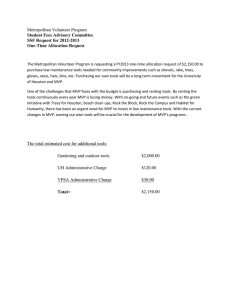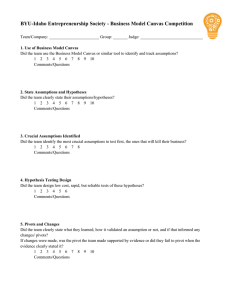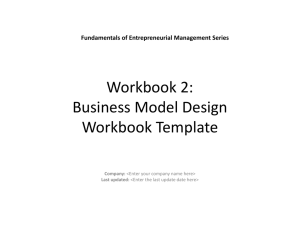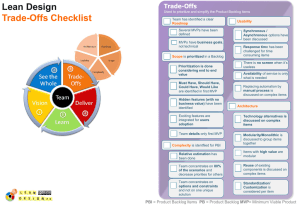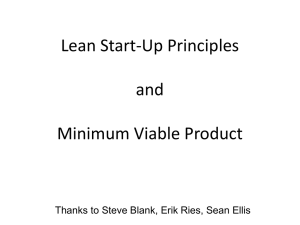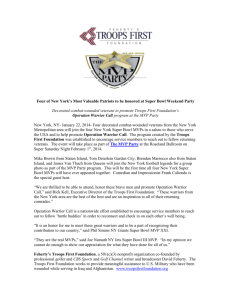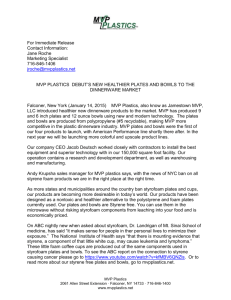Workbook 2: Business Model Process Workbook Template
advertisement
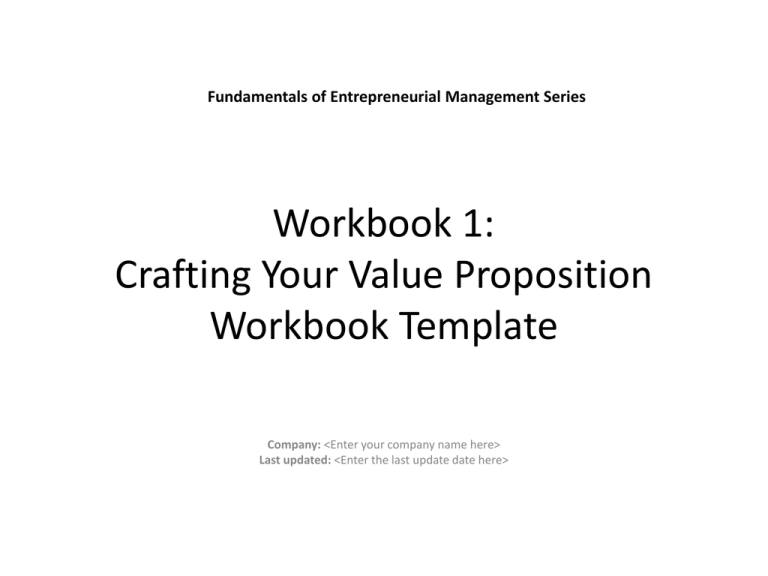
Fundamentals of Entrepreneurial Management Series Workbook 1: Crafting Your Value Proposition Workbook Template Company: <Enter your company name here> Last updated: <Enter the last update date here> Activity 1: Describe your idea Write a brief response to the following questions. • Who is your target customer? What kind of problem do you solve for them? • Is this an important problem for this customer? Is it an urgent problem? • How do you plan to solve this problem for the customer? Describe how your solution will work in the customer’s hands and the benefits that it will generate. • Who is your competition? How do they solve this problem for their customers today? • What is unique about your way of solving the problem? Why are you better than anyone else in solving this problem? Activity 2: The meaning of value List 15 to 20 values you derive from buying or doing things. Then create a short list that most accurately describes the value your product offers your customers. Activity 3: Crystallize your value proposition assumptions Review your answers to the following questions. Label each answer as Fact (and list the accompanying evidence) or Assumption (if you don’t have any evidence at this stage). No. Question 1. Who is your target customer? What kind of problem do you solve for them? 2. Is this an important problem for this customer? Is it an urgent problem? 3. How do you plan to solve this problem for the customer? Describe how your solution will work in the customer’s hands and the benefits that it will generate. 4. Who is your competition? How do they solve this problem for their customers today? 5. What is unique about your way of solving the problem? Why are you better than anyone else in solving this problem? Fact (with evidence) Assumption Activity 4: Test your target customer assumptions List the assumptions you made in Activity 3, and then answer the following questions. • What key piece of information would validate or invalidate the assumption? (Information) • Where does that information reside? Who has that information? (Where/Who) • What is the best way to gather that information? (Method) Assumption 1. 2. 3. Information Where/Who Method Activity 5: Prepare to talk to customers Gather answers to the following questions. What are the key political, regulatory, economic, environmental, social, cultural and technological trends that affect the space you are in? What are the key issues facing customers in this space? Who are the key stakeholders? Who are the analyst firms, analysts, journalists, bloggers and conference presenters that talk about relevant issues and technology? What are the main conferences and events? What are the main media outlets that keep people informed about the industry and its technology? Interview guide On the basis of the information in the previous checklist and the assumptions described in slide #5, prepare the questions and issues to address in your interview guide: After testing your assumptions EVALUATING AND UPDATING INFORMATION Activity 6: Evaluate market feedback Evaluate the results of your test. • Is the market problem urgent? Will customers care if the problem is not solved? Do they have another way to solve this problem? • Is the market problem pervasive? Determine if the identified market problem applies to a significant percentage of your desired target market. • Will your buyers pay to have this problem solved? • On the basis of the answers to the above questions, which direction should you take? Activity 7: Update your problem statement Write a brief description of the specific problem your target customers face, as well as the impact of the problem and its pervasiveness. Include the following information: • • • • The objective of their work: What are they trying to achieve? How they perform their work The problem they face How the problem impacts their objective Activity 8: Create your initial target customer list Create a list of target customers on the basis of the customer interview. Activity 9: Create a day-in-the-life scenario Address the following points to create a day-in-the-life scenario. No. Question 1 Who is the target customer? Personify your target customer: give them a name, an age, a gender and a job description. Imagine them as a real person with real problems. 2 What is their objective? What are they trying to do? 3 What challenges are they facing in pursuing those objectives? 4 What is the economic impact of not achieving those objectives? Answer Activity 9: Create a day-in-the-life scenario (cont’d) No. Question 5 Imagine the customer using your product. What are the qualities or capabilities in your product that allows the customer to change/overcome their challenge? 6 In what way do those capabilities affect the customer’s ability to achieve those objectives? 7 What is the measureable benefit for the customer of achieving those objectives? Answer Activity 10: Describe your product vision Write a statement that describes your product vision, which identifies one or more of the following: • • • • • Your target customers and their problem The product solution you are making How the user goes about their job and will use the product solution Customer outcomes and benefits Three- and five-year scenarios for your product and company Activity 11: Create the MVP Describe the key aspects of your MVP for which you are currently seeking market feedback. Activity 12: Test the MVP Answer the following questions after testing the MVP. • Is our understanding of the customer problem accurate and relevant? • Does the MVP solve the customer’s problem? • Does the product solve the problem better than a viable alternative currently on the market? • Would they use the product? Can they imagine the product as part of their everyday life? • What is their primary concern about buying and implementing the product? Activity 12: Test the MVP (cont’d) • How much would they be willing to pay for the product? • What process would the customer employ when deciding to buy such a product? • Who is involved in the decision-making process? • Whose budget will the funding come from? • Who will be the users of the product? Activity 13: Take the next steps Ask your team to help you answer these questions. • Has the customer problem been verified? • Has the product solution been validated? Activity 14: Create your value proposition Use the following template to create your value proposition. For (target customer) Who is looking for/challenged with (describe specific problem) We have developed (type of solution, maybe a word or two about how it works [e.g., fastworking, easy-to-use, cost-effective]) That helps/generates/creates/saves/improves (or any other benefit)
